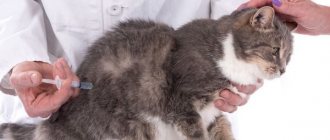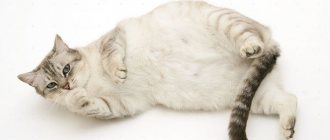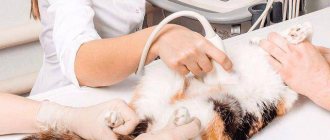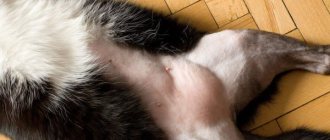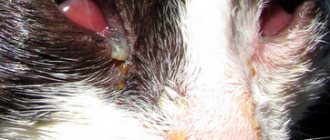Owners of domestic cats sometimes notice the appearance of discharge from the vaginal area, which is a liquid substance. The nature of the discharge may be serous or watery, and may also contain blood or pus (yellowish or green discharge). After the end of the birth process, vaginal discharge is dark, sometimes black or greenish.
The appearance of discharge from the vaginal area does not always indicate the development of a pathological process in the female reproductive system. Some types of discharge are physiologically determined and do not pose a threat to the life of the animal.
The presence of discharge in an animal should not be ignored, since in some cases such a symptom indicates the development of pathological changes in the area of not only the genital tract, but also the urinary system. It is recommended to contact a veterinary clinic to determine the nature of the origin of the cat’s discharge. The doctor will be able to make an accurate diagnosis and prescribe appropriate treatment.
Discharge in a cat, which is a physiological norm
During heat, a cat secretes a clear fluid that goes unnoticed because the cat is constantly licking itself. Twenty days after mating, a pregnant cat secretes a little clear and thick mucus in her urine. This is part of the plug that clogs the cervix, necessary to protect the organ from infection.
In the sixth week of gestation, excess amniotic fluid is released. You need to be sure whether the cat is pregnant. If this is the case, then the release of a small amount of clear liquid is not a cause for concern.
A few hours before birth, white or yellowish discharge appears, sometimes slightly bloody. After the start of contractions, the amniotic fluid leaves, greenish or fawn, transparent.
Causes of discharge
Overall, when it comes to the problem of "cat leaking brown fluid", there are several suspects, but anal sac disease is at the top of the list.
FYI: If you lift a cat's tail, you will see two anal glands located slightly below the anus on either side. Because the glands are embedded in muscles, they are difficult to see from afar. In either case, the role of the anal glands is to secrete a yellow-brown fluid when the cat defecates. As you might expect, the smell of liquids is far from pleasant, but cats rely on liquids to mark their territory.
© shutterstock
Usually, a cat's anal glands work as intended, but sometimes something can cause them to produce a thicker-than-normal fluid. Because the pores on the glands cannot drain fluid sufficiently, the glands become larger and larger. After some time, cats will understand what is happening and will try to manually get rid of the fluid in the glands by licking, tugging, ...
If pets can successfully empty their congested anal glands, then everything is fine. On the other hand, if pets can't do anything on their own, people need to step in.
What happens if an owner ignores their cat's plight? Well, pets suffering from anal sac disorder experience severe discomfort that is a direct result of the strange activity of the anal glands. Moreover, when affected cats lick their butts over and over again to cause discharge, they introduce bacteria from their mouth to the area. This means that the risk of urinary tract infection increases dramatically. Finally, the glands may one day burst, causing severe pain, infection and possibly death.
What kind of discharge in cats is considered unhealthy?
Suspicions of a pathological process are caused by vaginal discharge of the following type and consistency:
- White, if they are not associated with pregnancy or childbirth, then indicate vaginitis or pyometra. An additional pathological symptom is an unpleasant odor.
- Yellow-colored or bloody, foul-smelling, occur with postpartum endometritis or miscarriage.
Be sure to read:
Seizures in a cat: physiological and pathological causes, symptoms, first aid, treatment
Purulent discharge
The inflammatory process begins with the release of liquid transparent mucus, which gradually thickens, becomes opaque, first white, then acquires a creamy, yellowish, greenish or brown color. Darkening of the exudate is a sign indicating the death of mucosal tissue.
Your cat is bleeding: what to do?
When blood flows from the vagina in drops, clots, or along with exudate, it means that the cat has developed hematometra - a life-threatening illness.
The symptom indicates a violation of the integrity of blood vessels. In this case, urgent veterinary assistance is required.
Purulent, bloody, or yellow discharge
Bloody, purulent or yellow vaginal discharge in a cat almost always indicates the development of inflammation. Bloody discharge in a cat during the postpartum period is considered normal and is called lochia. They can be pinkish, dark brown or almost black. The duration of lochia is from 2 to 3 weeks. Normally, discharge after childbirth should not have an unpleasant odor.
It is important to note that during the onset of the heat period, cats, unlike dogs, do not experience bleeding. Therefore, if an animal intensively licks the vulva area, and droplets of blood are visible on the bedding, it is necessary to contact a veterinary hospital for advice as soon as possible.
Yellow or white discharge is normal before labor begins. A day or several hours before birth, the owner may notice the appearance of clear, whitish or greenish discharge from the loop. Discharge that does not go away for a long time and has an unpleasant odor is a signal of the development of pathology. You cannot do without the help of a veterinarian. When examined by a specialist, the female is not only given a clinical examination, but also prescribed a number of laboratory tests. An obligatory point in making a diagnosis is ultrasound diagnostics.
Among the pathological causes that provoke the appearance of specific exudate from the vagina in a cat are the following:
- Pyometra is a dangerous pathology caused by purulent-necrotic inflammation in the uterine cavity. In the open form of pyometra, exudate is released, initially cream-colored, then green, yellow, bloody with impurities of pus. In some cases, conservative treatment is carried out, which is effective in the initial stages of the disease. In case of advanced pathological process, it is recommended to perform extirpation of the uterus and appendages.
- Hematometra is a disease characterized by the accumulation of a large amount of blood in the uterus against the background of hemorrhage, provoked by an advanced form of endometritis or mechanical damage. Symptoms of hematometra in a cat are bloody discharge from the loop, liquid or in the form of clots, and have an unpleasant odor. Pathogenic microflora often joins, which leads to the appearance of pus.
- Hydrometra is a pathological process that occurs against the background of other diseases, for example, endometritis that is not treated in a timely manner. It is characterized by an increased accumulation of serous exudate in the uterine cavity.
- Endometritis is a commonly diagnosed disease in unsterilized cats. Pathology occurs as a result of the development of inflammation on the inside of the uterine layer. The disease can occur in both acute and chronic forms. The discharge in the initial stages of endometritis is cloudy, yellowish, and has a repulsive odor. Endometritis does not pose a direct threat to the life of a cat, but it is fraught with the development of complications in the absence of therapy.
Before contacting a veterinary clinic, the owner should carefully examine the type of discharge, its intensity, smell and color. This will help the doctor collect a medical history to make an accurate diagnosis. A number of important studies are carried out in the clinic, including:
- general clinical blood test;
- blood biochemistry;
- bacterial culture of vaginal exudate samples to determine the sensitivity of microflora to antibiotics;
- scraping for cytological examination;
- ultrasound diagnostics of the abdominal organs.
In some cases, it is recommended to conduct serological tests for herpes and brucellosis, and study the functioning of the renal system (to determine possible concomitant pathologies).
If the discharge that appears from the vaginal area in a female is physiologically caused, therapy is not carried out. In clinical veterinary practice, there have been cases of vaginitis occurring in young cats. After going through the first heat or undergoing a sterilization procedure, vaginitis disappears on its own.
Pathological vaginal discharge requires concentration from a specialist to make a diagnosis and prescribe treatment. Depending on the type of pathology and the degree of neglect, treatment will vary.
If a cat has an infection of the reproductive system with damage to the walls of the uterus, a foreign body is found in the birth canal, or malignant tumors are diagnosed, surgical treatment is prescribed. Surgical treatment is also carried out when diagnosing congenital anomalies in the structure of the ureter and the walls that form the vaginal opening.
Purulent discharge caused by the attachment and development of pathogenic bacterial microflora is stopped with the help of antimicrobial agents. A course of antibiotic therapy is prescribed, the dosage and treatment regimen of which is determined by the veterinarian.
If disorders in the blood clotting system are diagnosed, corrective treatment is carried out. In some cases, when the cause of a cat’s discharge from the loop is a tumor, not only surgery is performed, but chemotherapy is also prescribed.
A cat has white uterine discharge: normal or pathological?
White genital discharge, if it is not associated with pregnancy or labor, is pus. Most often they occur due to decreased immunity as a result of the use of hormonal contraceptives or hormonal anti-inflammatory drugs.
Staphylococci are activated, which constantly live in the body and do not cause harm to health with a normally functioning immune system. Vaginitis develops.
Another cause of the disease is the consequences of mating with a cat infected with chlamydia, toxoplasma, feline immunodeficiency virus, and mycoplasma.
After a difficult birth, fragments of the placenta remain in the uterus, they fester, leading to endometritis. The most dangerous pathology that begins with white discharge is pyometra. The discharge becomes colored or stops. If additional symptoms appear - depression, pain in the enlarged abdomen, it means that pyometra has passed into the most dangerous - closed form. The pus does not come out, but accumulates inside the uterus.
In older animals, suppuration may be a symptom of a tumor process. The main reason for the occurrence of neoplasms is repeated hormonal disruptions caused by the termination of an unwanted pregnancy or the use of drugs to disrupt estrus.
First, a false pregnancy develops. The animal gets worried, begins to prepare the nest, and spoils the situation. She produces milk, but no kittens. Repeated imaginary tightness is dangerous because it triggers the process of development of neoplasms.
Be sure to read:
What to do if your cat’s ears are red, itchy or spots appear: causes of the disease
Prevention
If fluid drips from the organs of the genitourinary system for physiological reasons, but the animal is not planned to be mated, it is better to sterilize it to avoid pathological complications associated with hormonal surges. When a cat has a history of inflammatory and other diseases of the urinary system, it is recommended to periodically visit a veterinarian, do a preventive ultrasound, promptly treat internal diseases, do routine vaccinations, and if pathological symptoms develop, do not self-medicate, but find out the diagnosis as soon as possible and begin treatment. therapy under the supervision of a physician.
Treatment of white discharge in cats
If leucorrhoea is accompanied by an unpleasant odor, this is a reason to contact a veterinarian. After a clinical examination and laboratory tests, the doctor assesses the general condition of the cat and prescribes treatment. prescribes treatment.
With timely treatment, it is possible to use conservative therapy methods. Vaginitis or open pyometra is treated with douching. The cat owner should ask a veterinarian or experienced felinologist how this is done.
Medicines based on furatsilin or chlorhexidine are taken into a rubber syringe and carefully squeezed into the vagina. At the same time, oral antibiotics or sulfonamides are prescribed.
The radical method of treatment is castration. Indications: closed pyometra, cancer, age over 6 years. In Russia, castration is called sterilization, although these are different operations.
Residents of high-rise buildings get a cat, but do not know what to do with it when it reaches sexual maturity. The call of nature, not supported by mating, causes torment for the pet and those around her. A reliable way to prevent it is to remove the uterus with ovaries and appendages at 8-10 months.
In this case, the cat will never have white or differently colored discharge from the loop. The disadvantage is the need to use expensive specialized food for sterilized cats to avoid obesity.
Treatment
Therapeutic measures are prescribed if it is determined that vaginal discharge is pathological. Depending on the diagnosis, the following medical techniques are used:
- Hemostatic therapy if a blood clotting disorder is established.
- Inhibition of the activity of pathogenic microflora. Antibiotic therapy.
- Extirpation of the uterus.
- Removal of tumors.
The use of steroidal antiphlogistic drugs is contraindicated. An attempt at self-medication poses a mortal threat to the pet, causing immediate death or provoking the formation of malignant tumors.
We invite you to join our Zen channel and group on VKontakte or Odnoklassniki, where new articles for pet owners are published.
Similar articles:
- My cat has a nosebleed - what should I do?
- Inflammation of the lower lip in a cat
- Clear nasal discharge in cats
Additional symptoms
For different diseases, the following are possible:
- increased and/or difficulty urinating, which is painful and can therefore cause anxiety and even aggression;
- it’s hard for the poor thing to go “big”;
- for a long time the cat rubs its butt on the floor (or rolls on the floor);
- licks himself from behind too often, because the discharge irritates the skin;
- complete apathy; drowsiness; vomit; fever; increased thirst; poor appetite; abdominal enlargement.
